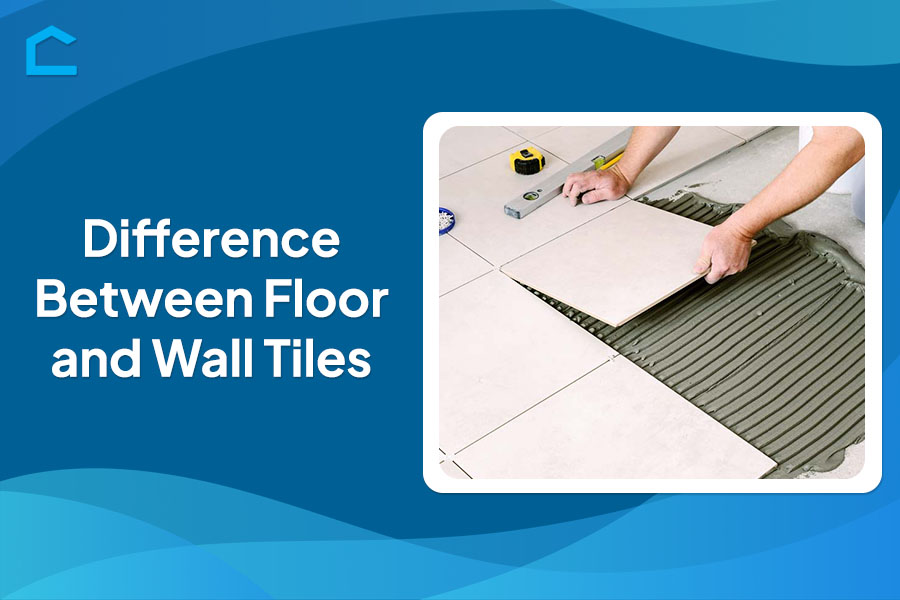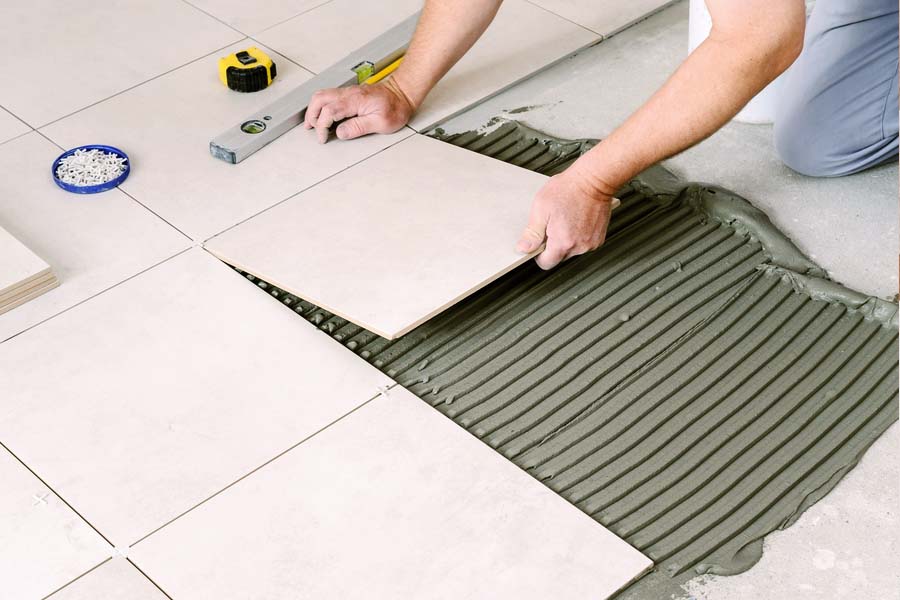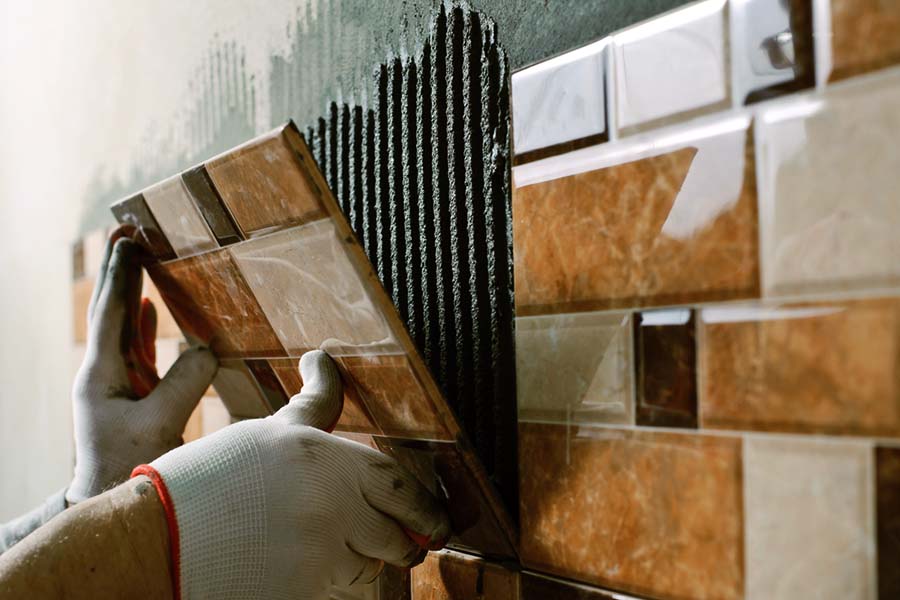Difference Between Floor and Wall Tiles

When it comes to tiling, it’s important to understand the distinct purposes and features of floor and wall tiles. These two types of tiles may appear similar at first glance, but they are designed and manufactured with specific characteristics to meet the unique demands of their respective applications.
In this comprehensive article, we will delve into the key difference between floor and wall tiles, exploring factors such as durability, slip resistance, thickness, and installation requirements.
Whether you’re planning a bathroom remodel, a kitchen renovation, or any other tiling project, understanding these distinctions is crucial. It will help you make decisions that ensure both functionality and aesthetic appeal.

Source: shutterstock.com / Photo Contributor: AYDO8
What Are the Differences between Floor and Wall Tiles?
Tiles, as a flooring option, are designed to be thicker and more durable to withstand heavy weight and foot traffic, often featuring a textured surface to prevent slipping.
On the other hand, wall tiles are typically thinner and lighter since they don’t need to support as much weight. They usually have a smoother finish for easier cleaning.
So, while both serve aesthetic and functional purposes, the key differences lie in their thickness, weight-bearing capacity, and surface texture.
Exploration of Floor and Wall Tiles
Tiles offer durability and aesthetics for floors and walls. Floor tiles vary in thickness for load-bearing – thicker for commercial spaces and thinner for residential areas.
For walls, tile thickness is less critical, but weight is a factor – heavy tiles need to be placed on sturdy walls. The surface texture of wall tiles ranges from glossy to matte finishes.
If you need to add wall tiles in the bathroom or kitchen, we recommend adding moisture-resistant tiles like ceramic. Regarding maintenance, glazed tiles are easy to clean, while unglazed tiles require more maintenance.
The Difference Between Floor and Wall Tiles
Material composition
Tiles are available in a variety of materials, each with its unique properties and suitability for different applications. Ceramic tiles, made from clay and other natural materials, are durable and suitable for both floor and wall installations.
Porcelain tiles, being denser and less porous than ceramic, offer exceptional durability, making them ideal for high-traffic areas. Their hardness and resistance to wear and tear make them a popular choice for commercial settings.
Natural stone tiles, such as marble, granite, and slate, provide a luxurious look but require more maintenance. They are porous and can be susceptible to staining, making them better suited for low-traffic areas or with proper sealing.
Glass tiles, on the other hand, are non-porous and easy to clean, making them suitable for walls and low-traffic floor areas. Their smooth surface and wide range of colors make them a stylish choice for modern spaces.

Source: shutterstock.com / Photo Contributor: DUO Studio
Surface finish
In addition to material composition, the surface finish of tiles significantly impacts their appearance and functionality. Matte finishes offer a subtle, non-reflective look, while glossy finishes reflect light, creating a sleek and modern appearance.
Glossy finishes are also easier to clean and maintain, making them a practical choice for kitchens and bathrooms. However, textured finishes provide a unique aesthetic and also offer slip resistance, making them ideal for areas prone to moisture.
They can add visual interest and create a safe walking surface in bathrooms or outdoor areas. The choice of surface finish depends on the desired look and the specific requirements of the installation area.
Water absorption rate
Another important factor to consider when choosing between floor and wall tiles is their water absorption rate. Floor tiles typically have lower water absorption rates than wall tiles. This makes them ideal for wet areas such as bathrooms and kitchens, where moisture resistance is essential.
Low water absorption rates help prevent staining, discoloration, and the growth of mold or mildew. While wall tiles can have slightly higher water absorption rates, they are still designed to withstand moisture to a certain extent.
Installation considerations
The installation process for floor and wall tiles differs in terms of techniques and required materials. Floor tiles require a solid, level substrate and heavy-duty adhesive to withstand the weight and foot traffic they will be subjected to.
Proper substrate preparation, such as leveling and priming, is crucial for a successful installation. In contrast, wall tiles need a sound base and flexible, lightweight adhesive to accommodate any potential movement or expansion.
Factors such as substrate preparation, adhesive selection, and grout type also vary depending on whether the tiles are intended for floor or wall applications. Following manufacturer recommendations and industry best practices is essential for a long-lasting and durable installation.
Can You Use Floor Tile Adhesive on Walls?
A common question that arises is whether floor tile adhesive can be used on walls. What is the difference between wall and floor tile adhesive? It is important to note that floor tile adhesive is designed specifically for horizontal, load-bearing surfaces.
Using it on walls may compromise adhesion and lead to tile failure over time due to the different stresses and movements involved. In contrast, wall tile adhesive is designed for vertical applications. It offers flexibility to accommodate minor movements or expansions in the wall substrate.
Moreover, wall adhesive is also typically lighter in weight, making it easier to work with on vertical surfaces. Using the correct adhesive for the intended application is crucial to ensure a successful and long-lasting installation.

Source: shutterstock.com / Photo Contributor: DUO Studio
Conclusion
In conclusion, understanding the fundamental difference between floor and wall tiles is crucial for any successful home renovation project. Recognize the distinct properties of tiles: durability, thickness, slip resistance, and maintenance.
With this knowledge, you will feel better prepared when selecting tiles for your floors and walls. We hope this article has helped you gain a clearer understanding of the key factors that set floor and wall tiles apart.
